Economics > QUESTIONS & ANSWERS > Clayton State University ECON 6100 Chapter 4 Extent How Much Decisions. 76 Questions and Answers. (All)
Clayton State University ECON 6100 Chapter 4 Extent How Much Decisions. 76 Questions and Answers.
Document Content and Description Below
1. If AVC=$5 and AFC=15, then AC= a. $15 b. $5 c. $20 d. $10 TOPICS: Section 1: Background: Average and Marginal Costs 2. Total cost divided by the number of units produced is called: a. tota... l cost b. average cost c. marginal cost d. variable cost TOPICS: Section 1: Background: Average and Marginal Costs Use the following to answer questions 3-8: Number of Workers Total Cost 0 1000 1 2200 2 3200 3 4000 4 4600 5 5000 6 5200 7 5600 8 6200 9 7000 10 8000 3. The marginal cost of hiring the 7th worker is a. $0 b. $1,000 c. $400 d. $200 TOPICS: Section 1: Background: Average and Marginal Costs 4. If the firm hires 8 workers, the total fixed costs is a. $600 b. $1,200 c. $1,000 d. $6,200 TOPICS: Section 1: Background: Average and Marginal Costs 5. If hiring the 4th worker increases total product by 50 units and the price of each unit is $15, a. the firm should not hire the 4th worker as MR<MC b. the firm should not hire the 4th worker as MR<TC c. marginal revenue equals $150 d. the firm should hire the 4th worker as MR>MC ANSWER: d TOPICS: Section 1: Background: Average and Marginal Costs 6. If the firm hires 5 workers, the average cost equals a. $80 b. $1,000 c. Need more information d. $10 TOPICS: Section 1: Background: Average and Marginal Costs 7. If the firms hires 5 workers and produces 5 units, the average variable costs equals a. $100 b. Need more information c. $800 d. $10 TOPICS: Section 1: Background: Average and Marginal Costs 8. What is the average total cost of producing 7 units if you hire 7 workers? a. $1,200 b. $800 c. $400 d. $1,600 TOPICS: Section 1: Background: Average and Marginal Costs 9. A firm produces 500 units per week. It hires 20 full-time workers (40 hours/week) at an hourly wage of $15. Raw materials are ordered weekly and they costs $10 for every unit produced. The weekly cost of the rent payment for the factory is $2,250. How do the overall costs breakdown? a. total variable cost is $17,000; total fixed cost is $2,250; total cost is $19,250 b. total variable cost is $5,000; total fixed cost is $2,250; total cost is $7,250 c. total variable cost is $5,000; total fixed cost is $14,250; total cost is $19.250 d. total variable cost is $12,000; total fixed cost is $7,250; total cost is $19,250 TOPICS: Section 1: Background: Average and Marginal Costs 10. If AVC=$15 and AFC=$10, then ATC= a. $25 b. $5 c. $15 d. $10 TOPICS: Section 1: Background: Average and Marginal Costs 11. If a firm produces 10 units, TC=$100. When the firm increase its output to 15 units, TC= $150. The firm’s variable costs equal to a. $50 b. $150 c. $25 d. $100 TOPICS: Section 1: Background: Average and Marginal Costs 12. If a firm produces 10 units, TC=$100. When the firm increase its output to 15 units, TC= $150. The firm’s AVC equal to a. $50 b. $100 c. $5 d. $10 ANSWER: d TOPICS: Section 1: Background: Average and Marginal Costs 13. A firm produces 1000 units per week. It hires 10 full-time workers (40 hours/week each) at an hourly wage of $20. Raw materials costs $5 per unit. Rent for the factory is $1,500 per week. What are the overall costs for the week? a. total variable cost is $5,000; total fixed cost is $1,500; total cost is $6,500 b. total variable cost is $13,000; total fixed cost is $9,500; total cost is $22,500 c. total variable cost is $13,000; total fixed cost is $1,500; total cost is $14,500 d. total variable cost is $5,000; total fixed cost is $9,500; total cost is $14,500 TOPICS: Section 1: Background: Average and Marginal Costs 14. In the short run, a. Some production costs are fixed b. All inputs are fixed c. All inputs are variable d. None of the above TOPICS: Section 1: Background: Average and Marginal Costs 15. Total costs increase from $1,500 to $1,800 when a firm increases output from 40 to 50 units. Which of the following are true? a. FC = $400 b. FC = $100 c. MC = $30 d. MC = $300 TOPICS: Section 1: Background: Average and Marginal Costs 16. Total costs increase from $1,500 to $1,800 when a firm increases output from 40 to 50 units. Which of the following are true? a. VC rise by $1,800 b. VC rise by $0 c. VC rise by $300 d. VC rise by $1,500 TOPICS: Section 1: Background: Average and Marginal Costs 17. Total costs increase from $1,500 to $1,800 when a firm increases output from 40 to 50 units.. Which of the following are true? a. AC rise by $1.00 b. AC fall by $1.50 c. AC rise by $1.50 d. AC fall by $1.00 TOPICS: Section 1: Background: Average and Marginal Costs Use the following to answer questions 18-24: Number of Workers Total Cost 0 50 1 110 2 160 3 200 4 240 5 250 6 260 7 280 8 310 9 350 10 400 18. The marginal cost of hiring the 4th worker is a. $100 b. $40 c. $20 d. $0 TOPICS: Section 1: Background: Average and Marginal Costs 19. If the firm hires 5 workers, total fixed costs equals a. $50 b. $200 c. $250 d. $1,200 TOPICS: Section 1: Background: Average and Marginal Costs 20. If the firm produces 5 units, average fixed costs equals a. $15 b. $5 c. $10 d. $20 TOPICS: Section 1: Background: Average and Marginal Costs 21. If hiring the 6th worker increases total product by 7 units and the price of each unit is $2, a. the firm should not hire the 6th worker as MR<MC b. the firm should not hire the 6th worker as MR<TC c. marginal revenue equals $2 d. the firm should hire the 6th worker as MR>MC ANSWER: d TOPICS: Section 1: Background: Average and Marginal Costs 22. If hiring the 7th worker increases total product by 5 units and the price of each unit is $2, a. the firm should not hire the 7th worker as MR<TC b. the firm should not hire the 7th worker as MR<MC c. marginal revenue equals $2 d. the firm should hire the 7th worker as MR>MC TOPICS: Section 1: Background: Average and Marginal Costs 23. If the firm hires 5 workers, and produces 10 units, the average cost equals a. $5 b. $250 c. Need more information d. $25 ANSWER: d TOPICS: Section 1: Background: Average and Marginal Costs 24. If the firm hires 5 workers, and produces 10 units, the average variable costs equals a. $50 b. $80 c. $20 d. $200 TOPICS: Section 1: Background: Average and Marginal Costs 25. Marginal cost is ____________. a. The revenue from selling an additional unit of output b. none of the above c. The total cost of production d. The cost of producing an additional unit of output ANSWER: d TOPICS: Section 1: Background: Average and Marginal Costs 26. Marginal revenue is_____________. a. The total revenue gained from production b. The cost of producing an additional unit of output c. The revenue from selling an additional unit of output d. none of the above TOPICS: Section 1: Background: Average and Marginal Costs 27. Which of these is a variable cost for a restaurant? a. Insurance against damages on the rental space b. Rent for dining space c. Wages for the servers d. Tax accountant’s salary TOPICS: Section 1: Background: Average and Marginal Costs 28. If a firm produces 8 units of output with average fixed cost=$40 and average variable cost=$25, what is its total cost? a. $200 b. $1,000 c. $520 d. $320 TOPICS: Section 1: Background: Average and Marginal Costs 29. If a firm produces 8 units of output with average fixed cost=$40 and average variable cost=$25, what is its average cost? a. $100 b. $20 c. $65 d. $32 TOPICS: Section 1: Background: Average and Marginal Costs 30. If a firm produces 8 units of output with average fixed cost=$40 and average variable cost=$25, what is its total fixed cost? a. $650 b. $1,000 c. $200 d. $320 ANSWER: d TOPICS: Section 1: Background: Average and Marginal Costs 31. If a firm produces 8 units of output with average fixed cost=$40 and average variable cost=$25, what is its total variable cost? a. $200 b. $320 c. $1,000 d. $650 TOPICS: Section 1: Background: Average and Marginal Costs 32. With fixed costs of $200, a firm has average total costs of $5 and average variable costs of $3. Its output is: a. 66.67 units. b. Need more information c. 100 units. d. 40 units. TOPICS: Section 1: Background: Average and Marginal Costs 33. Average cost of production is a. Total variable cost divided by total units produced b. Equal to marginal cost c. Total fixed cost divided by total units produced d. Total cost divided by total units produced ANSWER: d TOPICS: Section 1: Background: Average and Marginal Costs 34. Jim’s Burgers produces 500 burgers per week. He can sell as many burgers as he can cook for $3. What is the marginal revenue from selling the 50th burger? a. $3 b. $150 c. $147 d. It cannot be determined with the information given TOPICS: Section 1: Background: Average and Marginal Costs 35. Jim’s Burgers produces 600 burgers per week. Each burger sells for $3. Goody Candy orders 500 burgers for its upcoming office party from Jim’s Burgers. Jim decided to accept the order for $1250 lump sum. What would be the marginal revenue per burger for this order? a. $3 b. $2.50 c. $0.50 d. It cannot be determined with the information given TOPICS: Section 1: Background: Average and Marginal Costs 36. Managers undertake an investment only if a. Marginal revenue is greater than zero b. Marginal costs is less than marginal revenue c. Marginal revenue is greater than marginal costs d. Investment decisions do not depend on marginal analysis TOPICS: Section 2: Marginal Analysis 37. According to the law of diminishing returns a. Production increases at a decreasing rate b. Production increases at a increasing rate c. Production decreases at a decreasing rate d. Production decreases at an increasing rate TOPICS: Section 2: Marginal Analysis 38. The level of an economic activity should be increased to the point where the ____. a. Marginal cost=0 b. Marginal revenue=0 c. Total revenue = Total cost d. Marginal revenue – marginal cost=0 ANSWER: d TOPICS: Section 2: Marginal Analysis 39. Marginal cost a. Is the incremental cost incurred by producing an additional unit of output. b. Is the total cost of production. c. Is the total fixed cost of production. d. None of the above TOPICS: Section 2: Marginal Analysis 40. When economists speak of “marginal”, they mean a. Opportunity b. Scarcity c. Incremental d. Unimportant TOPICS: Section 2: Marginal Analysis 41. A manager of a clothing firm is deciding whether to add another factory in addition to one already in production. The manager would compare a. The total revenue gained from the two factories to the total costs of running the two factories. b. The marginal revenue expected from the second factory to the total costs of running the two factories. c. The marginal revenue expected from the second factory to the marginal cost of the second factory. d. The total revenue gained from the two factories to the marginal costs of running the two factories. TOPICS: Section 2: Marginal Analysis 42. Comfy Clothing is thinking of hiring Tom. If hired, he can increase total production by 100 units a week. He would cost the firm $1,500 a week in wages. If the price of each unit is $20, a. The MR of hiring the worker is $1,500 b. The MC of hiring Tom is $1,500 c. The firm should hire Tom since MR>MC d. All the above ANSWER: d TOPICS: Section 2: Marginal Analysis 43. Marginal revenue a. Is the additional revenue earned by selling one more unit b. Is always equal to the total revenue c. Is the difference between total revenue and total costs d. None of the above TOPICS: Section 2: Marginal Analysis Use the following table to answer questions 44 - 50: # Units Produced Total Revenue Total Costs 0 0 200 1 600 660 2 780 720 3 840 780 4 890 870 5 910 980 44. What is the marginal revenue from producing the fourth unit? a. 90 b. 50 c. 20 d. 180 TOPICS: Section 2: Marginal Analysis 45. What is the marginal cost of producing the third unit? a. 60 b. 70 c. 90 d. 110 TOPICS: Section 2: Marginal Analysis 46. How many units should the profit maximizing firm produce? a. 1 b. 2 c. 3 d. 4 TOPICS: Section 2: Marginal Analysis 47. What are the total profits if four units are produced? a. 40. b. 70. c. -30. d. 20. ANSWER: d TOPICS: Section 2: Marginal Analysis 48. What is the average cost per unit for producing 3 units? a. 200. b. 260. c. 70. d. 110. TOPICS: Section 2: Marginal Analysis 49. What is the average cost per unit if the firm produces 5 units? a. $196 b. $980 c. $182 d. $910 TOPICS: Section 2: Marginal Analysis 50. What is the marginal cost of the 5th unit? a. $100 b. $105 c. $110 d. $115 TOPICS: Section 2: Marginal Analysis 51. A student is trying to decide whether to study for the upcoming exam or play video games. The optimal amount of time spent studying is: a. where the total benefit of studying is equal to the total cost of studying. b. where the marginal benefit of studying is equal to the total cost of studying. c. where the marginal benefit of studying equals the marginal cost of studying. d. where the total benefit of studying equals the total cost of studying. TOPICS: Section 2: Marginal Analysis 52. Which of the following is FALSE? a. Increase production if MR>MC b. Produce where MR=MC c. Average cost is total cost per unit of production d. Produce where MR=AC ANSWER: d TOPICS: Section 2: Marginal Analysis 53. At the current level of production, if the firm’s MR>MC, then the firm should a. produce more b. the company is maximizing profit at this output c. producing less d. None of the above TOPICS: Section 2: Marginal Analysis 54. Farmer John can produce as much corn as he wants at the going price of $48 per bushel. At his current production level, the marginal cost is $18. What should the company do? a. Increase production b. Decrease production c. Stay at this level of production d. None of the above TOPICS: Section 2: Marginal Analysis Harvey’s Hardware is thinking about starting a line of lawnmowers to serve its customer base in the summer. The lawnmowers would be priced at $100 and Harvey the manager believes that they would sell 3 units. They have the following estimated costs. Use this information for questions 55-58 Units Produced Labor Cost Total cost 0 0 100 1 50 150 2 100 200 3 200 300 4 350 450 55. What is the marginal revenue from selling the third unit? a. $50 b. $100 c. $150 d. $0 TOPICS: Section 2: Marginal Analysis 56. What is the average cost of producing three units? a. $200 b. $100 c. $50 d. $70 TOPICS: Section 2: Marginal Analysis 57. What is the marginal cost of producing the third unit? a. $100 b. $200 c. $300 d. $400 TOPICS: Section 2: Marginal Analysis 58. How many units should Harvey’s Housewares produce? a. 1 unit b. 2 units c. 3 units d. Zero units, at these prices, the production should not start TOPICS: Section 2: Marginal Analysis 59. An airline’s flight is about to take off. It has a few empty seats left aboard. If it lowers its prices, it can fill the remaining seats and fly at full capacity. What should be done? a. Sell the additional standby seats at a discount since the marginal costs of the additional passenger are almost zero and fly at full capacity b. Sell the additional standby seats without a discount c. Don’t offer the additional seats for any price d. none of the above TOPICS: Section 2: Marginal Analysis 60. Cruise liners offer last minute deals because a. The marginal cost is higher than the marginal revenue since fixed costs are sunk b. The marginal costs of an additional passenger are very low at that point and companies gain by lowering prices c. The average cost of an additional passenger is very low at that point and companies gain by lowering prices d. All of the above TOPICS: Section 2: Marginal Analysis 61. Which of the following statements is TRUE? a. Average cost (AC) is irrelevant to extent decisions b. Average cost determines how much you produce c. Marginal cost (MC) is irrelevant to extent decisions d. All of the above TOPICS: Section 2: Marginal Analysis 62. If Marginal Cost (MC) is higher than Average Cost (AC), average cost is a. falling b. rising c. constant d. none of the above TOPICS: Section 2: Marginal Analysis 63. If Marginal cost is lower than Average Cost (AC), average cost is a. falling b. rising c. constant d. none of the above TOPICS: Section 2: Marginal Analysis 64. Food Fanatics caters meals where their cost of producing an extra meal is $25. Each of their meals is standard and sells for $20. At this rate what should the company do? a. Produce more meals and increase their profit b. Produce fewer meals and increase their profit c. Not change production d. None of the above TOPICS: Section 2: Marginal Analysis 65. Food Fanatics caters meals where their cost for producing an extra meal is $20. Each of their meals is standard and sells for $25. At this rate what should the company do? a. Produce more meals and increase their profit b. Produce fewer meals and increase their profit c. Not change production d. None of the above TOPICS: Section 2: Marginal Analysis 66. You own a tract of trees and are deciding whether to harvest them now or next year. If you harvest them now, you can invest the proceeds and get a return of 5% on your investment. What should you do? a. Let the trees grow as long as their dollar worth increases by more than 5% b. Let the trees grow c. Cut down the trees, and sell them d. Let the trees grow as long as their dollar worth increases by less than 5% TOPICS: Section 2: Marginal Analysis 67. The main difficulty in applying marginal analysis is a. calculating total cost b. determining which costs and revenues are relevant to a particular decision c. calculating average cost d. All of the above TOPICS: Section 2: Marginal Analysis 68. What is the Customer Acquisition Cost? a. Total cost of customers b. Average cost per customer c. The marginal cost of acquiring another customer d. All of the above TOPICS: Section 2: Marginal Analysis 69. Marginal cost typically ________ and marginal revenue typically _________ with increasing output. a. rises; falls b. falls; rises c. rises; rises d. falls; falls TOPICS: Section 2: Marginal Analysis 70. A widget producer is deciding whether to compensate widget makers on a salary basis or a per unit basis. Given that it is difficult to monitor shirking, which of these pay schedules would provide stronger performance incentives? a. Per piece compensation b. Salary c. Both of them d. Neither of them TOPICS: Section 3: Incentive Pay 71. Group disaster Mary, Jane, Janet and Samantha chose each other for a group project since they knew that they were all high achievers. Once the project rolled around however, their group actually did more poorly than the group where all the members knew that others were slackers. How did that happen? 72. Shoe-a-holic Cathy started her own line of custom made, hand embellished wedding shoes. She opened up her own shop paid $2500 in fixed licensing fee. She used about $3000 in raw materials and made $3500. At the end of the first month, Carly, her sister looked at her financials and told her that she was losing money and should shut down. Cathy is heartbroken. As an economics guru, what would you advise her to do? 73. Lemonade anyone? Raymond decides to set up a lemonade stand every weekend for the next four weeks to save up for the latest xmen comic. He has to pay his brother Robert $10 as a one-time payment for him to not bully Raymond or drive his customers away. The lemons and sugar cost him $10 (the water is free) and his dad offers to set up his stall for him. He ends up making $15 his first weekend. Frank, his father notices this and advises Raymond to shut down the stall since he is making less than he is spending on the stall. What would you advice Raymond to do? 74. Lemonade anyone? II Raymond decides to set up a lemonade stand every weekend for the next four weeks to save up for the latest xmen comic. He has to pay his brother Robert $10 as a one time payment for him to not bully Raymond or drive his customers away. The lemons and sugar cost him $10 (the water is free) and his dad offers to set up his stall for him. He ends up making $15 his first weekend. Frank, his father notices this and advises Raymond to shutdown the stall, while Marie his mother advises him not only to set up the stall next weekend but to increase production even more. Raymond is extremely confused. Who do you think he should listen to? 75. Cooling systems Carl is the lead engineer on a smart HVAC cooling system that works with minimal energy and is voice activated. Given the revolutionary nature of the system, it took many failed tries to create a system that actually worked, a cost of $30,000. Now each unit sells for $6500 and it costs $5000 in raw materials and labor to produce. What costs should Carl take into consideration when deciding to service the order for an additional unit? 76. Cooling systems II Carl is the lead engineer on a smart HVAC cooling system that works with minimal energy and is voice activated. Given the revolutionary nature of the system, it took many failed tries to create a system that actually worked, a cost of $30,000. Now each unit sells for $6500 and it costs $5000 in raw materials and labor to produce. Carl receives an order for four new units for a customer, but when he takes the order to his manager, the manager is enraged and asks Carl why he wanted to produce something at a loss. What costs would the manager be looking at to come to this conclusion? [Show More]
Last updated: 1 year ago
Preview 1 out of 15 pages
.png)
Reviews( 0 )
Recommended For You
Health Care> QUESTIONS & ANSWERS > SIRS & Sepsis set of 76 questions and answers 2022 (All)
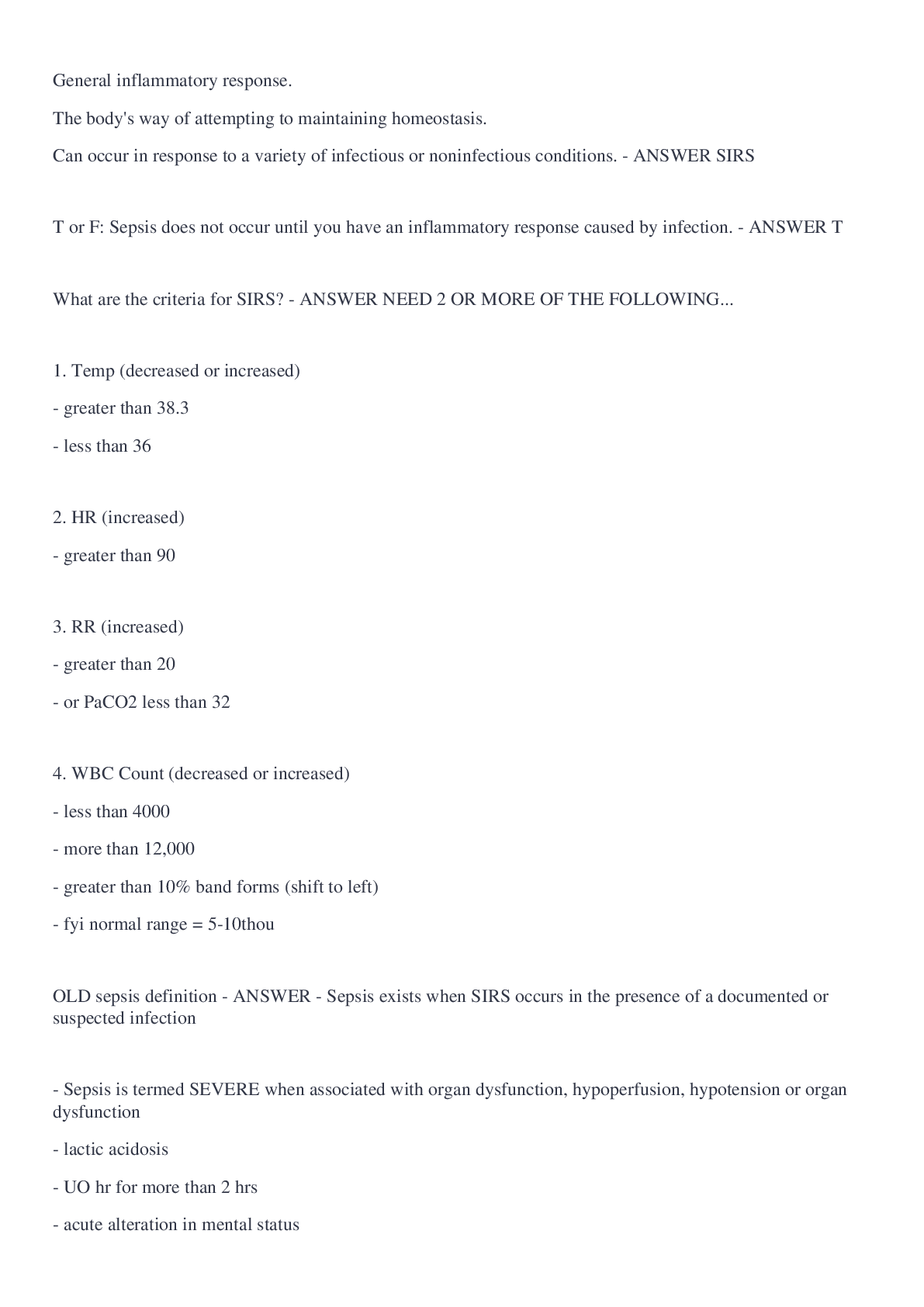
SIRS & Sepsis set of 76 questions and answers 2022
General inflammatory response. The body's way of attempting to maintaining homeostasis. Can occur in response to a variety of infectious or noninfectious conditions. - ANSWER SIRS T or F: Sepsis...
By MARKALLAN , Uploaded: Jul 09, 2022
$6
Economics> QUESTIONS & ANSWERS > Clayton State University ECON 6100. Chapter 8 Understanding Markets and Industry Changes. Contains 82 QnA and Solutions. (All)
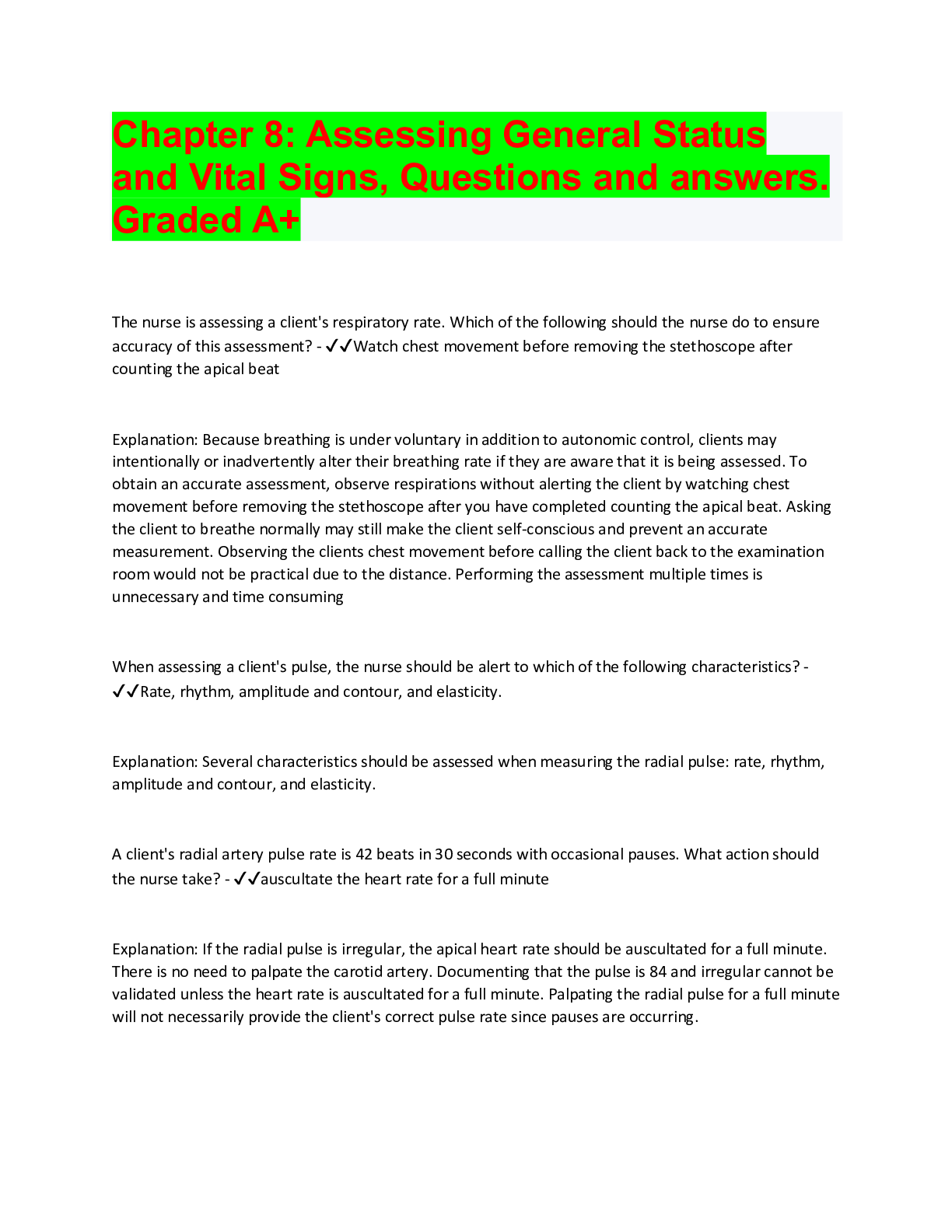
Clayton State University ECON 6100. Chapter 8 Understanding Markets and Industry Changes. Contains 82 QnA and Solutions.
1. Demand and supply analysis is particularly important if a. the success of your firm is closely linked to the profitability of your primary industry b. the success of your firm is independent of t...
By SuperSolutions© , Uploaded: Apr 16, 2022
$12
Economics> QUESTIONS & ANSWERS > Clayton State University ECON 6100 Chapter 9 Market Structure and Long Run Equilibrium. 73 Questions and Answers (All)
.png)
Clayton State University ECON 6100 Chapter 9 Market Structure and Long Run Equilibrium. 73 Questions and Answers
1. All of these are characteristics of a competitive industry, except: a. Many substitutes b. No barriers to entry c. Homogenous product d. Little or no information on rivals’ products TOPICS:...
By SuperSolutions© , Uploaded: Apr 16, 2022
$11
Economics> QUESTIONS & ANSWERS > Clayton State University ECON 6100 Chapter 2 The One Lesson of Business. 54 Question And Answers. (All)
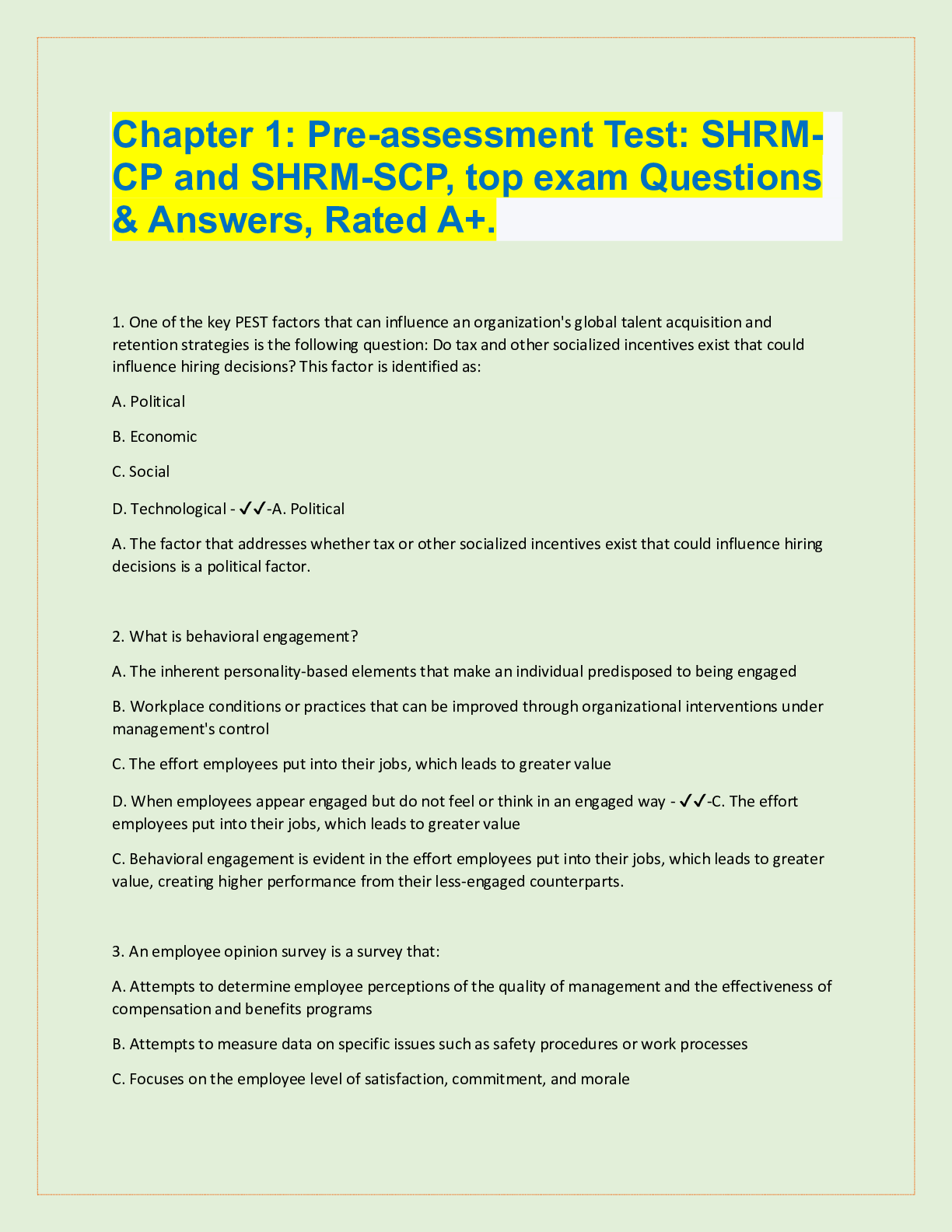
Clayton State University ECON 6100 Chapter 2 The One Lesson of Business. 54 Question And Answers.
1. One lesson of business: a. is tracing the consequences of a policy. b. promoting a policy change to eradicate inefficiencies. c. moving assets from lower to higher value uses, thereby creating w...
By SuperSolutions© , Uploaded: Apr 16, 2022
$9
Economics> QUESTIONS & ANSWERS > Clayton State University ECON 6100 Chapter 10 Strategy The Quest to Keep Profit From Eroding. 71 Questions and Answers (All)
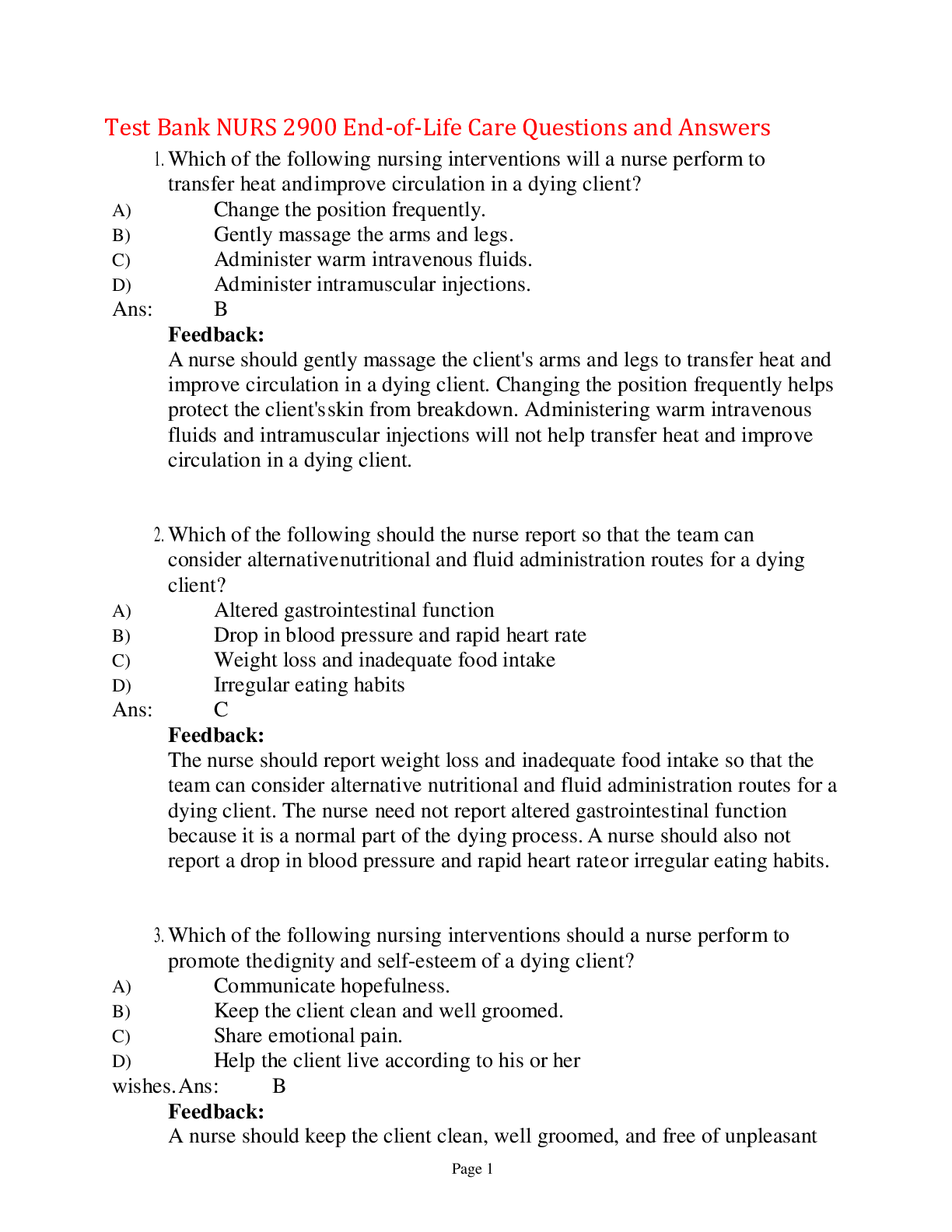
Clayton State University ECON 6100 Chapter 10 Strategy The Quest to Keep Profit From Eroding. 71 Questions and Answers
1. Firms maintain their completive edge by a. Providing a good at lower costs than their rivals b. Providing a superior product at the same cost as your rival c. Being innovative d. All the above...
By SuperSolutions© , Uploaded: Apr 16, 2022
$11
Economics> QUESTIONS & ANSWERS > Clayton State University ECON 6100 Chapter 7 Economies of Scale and Scope. 63 Questions and Answers (All)
.png)
Clayton State University ECON 6100 Chapter 7 Economies of Scale and Scope. 63 Questions and Answers
1. The law of diminishing marginal productivity states that a. As you expand output, your marginal productivity eventually increases b. As you expand output, your marginal productivity eventually de...
By SuperSolutions© , Uploaded: Apr 16, 2022
$11
Economics> QUESTIONS & ANSWERS > Clayton State University ECON 6100 Chapter 5 Investment Decisions Look Ahead and Reason Back. 85 Questions and Answers. (All)
.png)
Clayton State University ECON 6100 Chapter 5 Investment Decisions Look Ahead and Reason Back. 85 Questions and Answers.
1. The higher the interest rates a. the more value individuals place on future dollars b. the more value individuals place on current dollars c. individuals do not place any importance on either cu...
By SuperSolutions© , Uploaded: Apr 16, 2022
$12
Economics> QUESTIONS & ANSWERS > Clayton State University ECON 6100 Chapter 3 Benefits Costs and Decisions. 67 Questions and Answers. (All)
.png)
Clayton State University ECON 6100 Chapter 3 Benefits Costs and Decisions. 67 Questions and Answers.
1. Variable costs are a. costs that vary with output b. not important in decision making c. costs that do not vary with output d. equal to total costs TOPICS: Section 1: Background: Variable, f...
By SuperSolutions© , Uploaded: Apr 16, 2022
$11
Economics> QUESTIONS & ANSWERS > Clayton State University ECON 6100 Chapter 13 and 14 Direct and Indirect Price Discrimination. 84 Questions and Answers. (All)
.png)
Clayton State University ECON 6100 Chapter 13 and 14 Direct and Indirect Price Discrimination. 84 Questions and Answers.
1. Which of the following is an example of price discrimination? a. Seniors paying a lower price for tickets at movie theatres b. Students paying discounted rates on travel c. Tourists paying highe...
By SuperSolutions© , Uploaded: Apr 16, 2022
$11
Pharmacology> QUESTIONS & ANSWERS > ATI PHARMACOLOGY PROCTORED EXAM 2021 - Correct & Verified Questions with Answers / Already Graded A (76 questions and answers) (All)
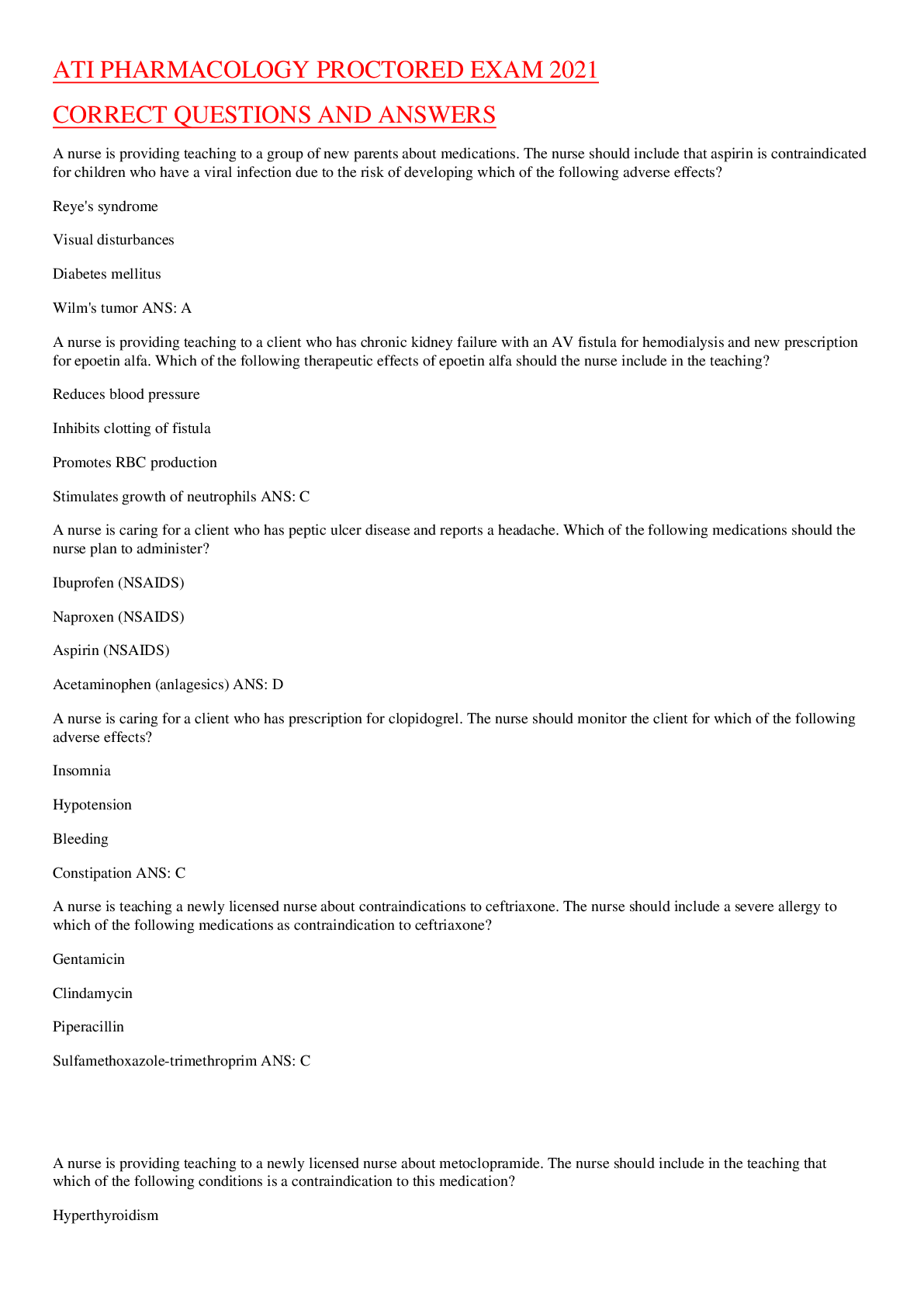
ATI PHARMACOLOGY PROCTORED EXAM 2021 - Correct & Verified Questions with Answers / Already Graded A (76 questions and answers)
1. A nurse is providing teaching to a group of new parents about medications. The nurse should include that aspirin is contraindicated for children who have a viral infection due to the risk of deve...
By Book Worm, Certified , Uploaded: Sep 10, 2022
$14
Document information
Connected school, study & course
About the document
Uploaded On
Apr 16, 2022
Number of pages
15
Written in
Additional information
This document has been written for:
Uploaded
Apr 16, 2022
Downloads
0
Views
50






